
Collection equipment and pictograms
Producers and their operators are obliged to supply collection equipment for the municipal collection and sorting of waste electronics and portable batteries. Below you can see producers’ range of equipment for the different fractions at your recycling centre, and you can see which standard pictograms you should use at the centres.
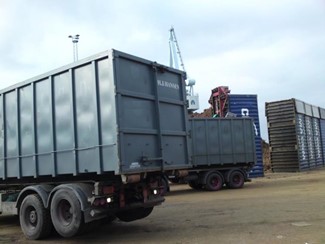
Fraction 1a. Large electronics and Fraction 2. Refrigeration equipment.
Large container
This type of equipment is used to collect large household appliances and refrigeration equipment corresponding to collection fractions 1 and 2. Opening: Containers come with openings at the front and/or rear end. The standard container has an opening at the rear end; if you need a front-end loader container at your centre, it is possible to select such type. • Name: Roll on roll off containers • Volume: 28-45 m3 • Material: Iron • Handling: Roll on roll off truck – hook or wire • No cover • Hatches at rear end (sites needing front-end hatches must contact the collective scheme, ERP does not carry this solution) • Length: 6-7 metres • Width: Maximum 2.55 metres • Height: Maximum 2.5 metres • Plane floor • Comes with lock fitting
Pictogram - Large electronics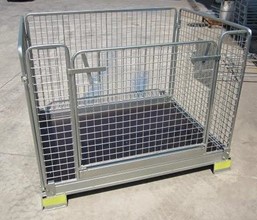
Fraction 1b. Medium-sized, Fraction 3: Small electronics, Fraction 4. Screens
Metal cage ERP
Metal cages are used to collect medium-sized and small household appliances as well as screens and monitors corresponding to collection fractions 1b and 3 and 4.
Pictogram - Small electronics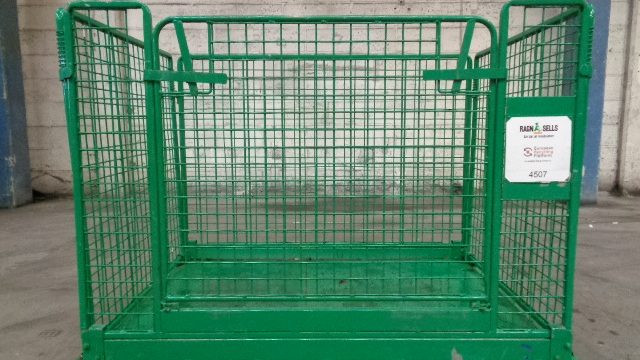
Metal cage - Elretur
• Measurements: 120 x 160 cm – height 120 cm. • Stackable • Folded up on delivery • Solid floor of wood//metal • Mesh size 5 x 5 cm or 9 x 22 cm. • Steel legs • Detachable front hatch
Pictogram 1b - Medium-sized equipment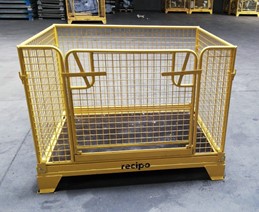
Metal cage Recipo
Ragn-sell and HCS deliver all over Denmark • Measurements: 120 x 160 cm – height 120 cm • Stackable.
Pictogram - Screens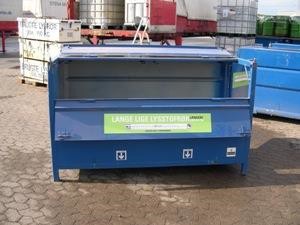
Fraction 5: Light sources
Boxes
These boxes are used for straight light sources such as fluorescent tubes longer than 60 cm. Shorter light sources including energy-saving bulbs must be collected in drums (latch closure) (see also below). Technical specifications: • Measurements: approximately 195 x 80 cm – Height 115 cm. • The container has hatches on the side and at the top; they open in two positions • Material: metal • Steel legs
Pictogram - fluorescent tubes
Drums, latch closure
Fraction 5: Light sources, Portable batteries, (Voluntary: Smoke detectors)
This type of equipment is used for the collection of light sources and batteries corresponding to fractions 5 and 6. Also used for radioactive smoke detectors if the local authority has chosen to collect those products separately - (voluntary but recommended) NOTE! Smoke detectors must be collected by those collective schemes and operators that collect the cage fraction. Technical specifications: • Plastic drums (latch closure) • Volume: 120 litres for batteries (ø 50 cm, h 80 cm), 200 litres for light sources (ø 60 cm, h 100 cm) • Loose lid. Place the lid after filling of waste to prevent water from entering the drum. • Loose lid. Place the lid after filling of waste to prevent water from entering the drum.
Pictogram - batteries
Fraction 6: Photovoltaic panels
Metal cage
Photovoltaic panels are collected separately as fraction 6. As a temporary solution it has been agreed between local authority associations and collective schemes to collect photovoltaic panels in cages until a better solution is available. It is assessed that the maximum load is 13 photovoltaic panels per cage.
Pictogram - Photovoltaic panelsShortcuts
Collection sites
See requirements for municipal collection sites, including description of electronics fractions
Regional sites 2023-2024
See regional collection sites for large quantities of waste electronics from households and similar
Collection equipment and pictograms
See producers’ collection equipment and the standard pictograms used by local authorities
Compliance schemes and handeling companies
See contact information of waste carriers and operators calling on municipal collection sites further to the annual allocation
Allocation
See who picks up end-of-life electronics and portable batteries at the municipal collection sites
Statistics for collected electronics
See volumes of waste electronics collected in the municipalities
Statistics for collected batteries
See how many batteries are collected in the municipalities
Cooperation between local authorities and producers
See guidelines for the cooperation between local authorities and producers, including requirements for sorting and pickup at collection sites